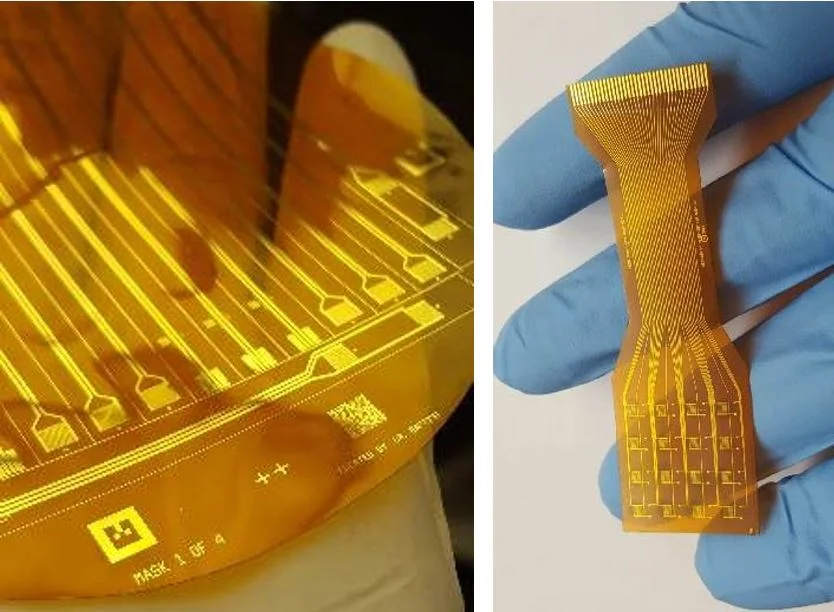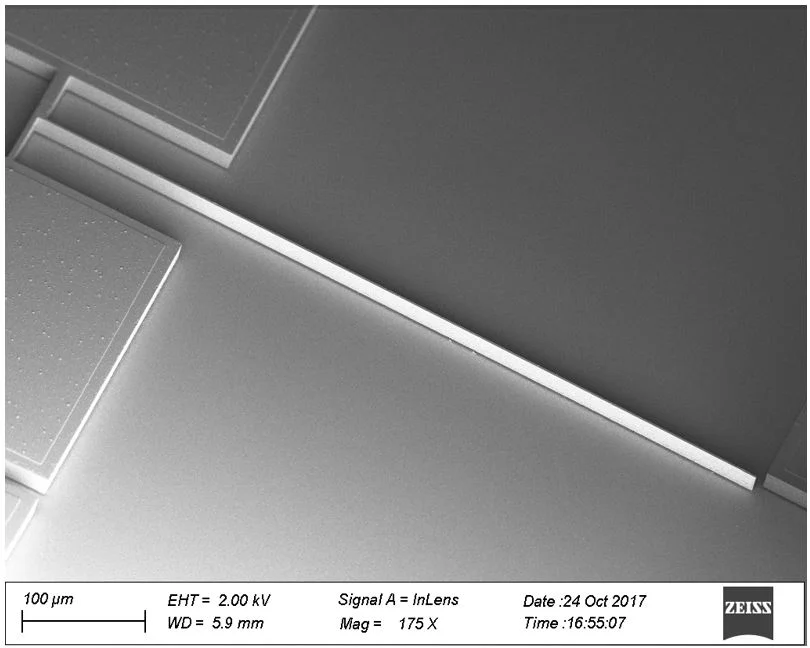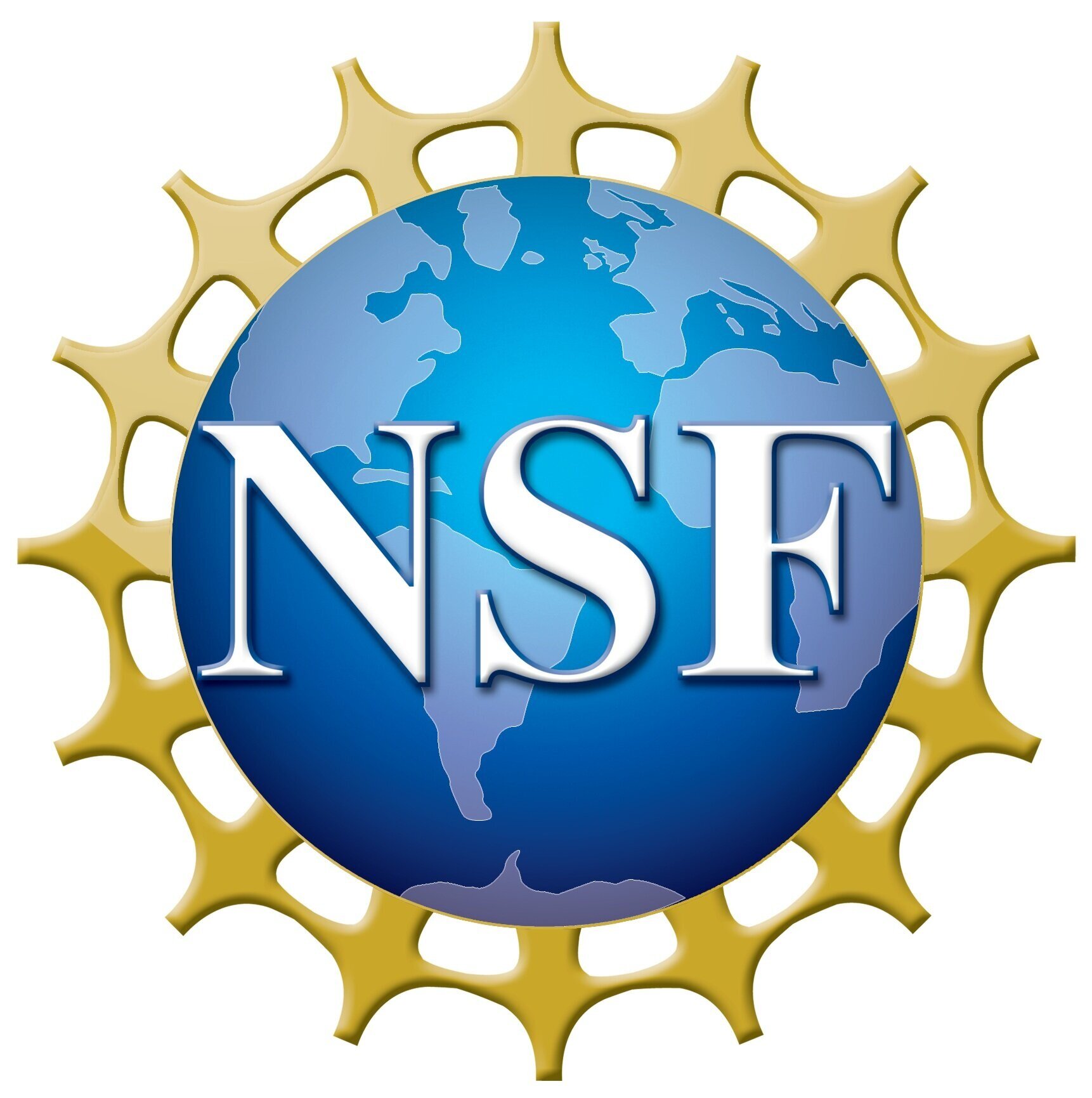A picture of a microreactor with inserted SEM micrograph to show the micropillars inside of the microreactor for capture of trace VOCs.
Xiaoan Fu and Michael Nantz, Department of Chemical Engineering, Department of Chemistry, University of Louisville. Work performed at University of Louisville Micro/Nano Technology Center.
Capture of trace volatile organic compounds in air and exhaled breath by microreactors
The objective of this work is to develop a highly efficient microreactor platform for capture of trace target volatile organic compounds (VOCs) in air and exhaled breath. There are thousands of micropillars in the microreactor coated with reactive compounds on the surfaces of the micropillar for capture of VOCs via chemoselective reactions. The adducts of reacted VOCs can be easily eluted with solvents and analyzed by standard GC-MS and UHPLC-MS. The microreactors has been used for identification of lung cancer biomarkers in exhaled breath for early detection of lung cancer and for detection of toxic compounds in environmental air.
SEM micrograph of mm-size rotary comb drive with 6 microns comb gaps. This rotary joint will be used as a an arm or base joint for AFAM.
Dan Popa, University of Louisville NSF grants #IIS 1633113 and #CMMI 1734383 Work performed at University of Louisville Micro Nano Technology Center
Fabrication of Microrobot Components for Wafer Scale Microfactories
This work targets multi-legged and multi-degrees of freedom microrobots fabricated on on SOI wafers with 20-100 µm device layer thickness. Microrobot components comprise of flexible joints, rigid links, and thermal of electrostatic microactuators. Microassembly techniques can be used to construct non-planar multi-degrees of freedom structures. Two types of robots are targeted for operation in a future wafer-scale microfactory:
A fixed mm-scale assembled robot arm (the AFAM, or ariticulated four axis microrobot). This robot can perform nanoindentation or pick and place of nanoscale objects.
A mobile, multi-legged microrobot driven by laser energy. This robot can perform controlled locomotion in a plane with a single modulated laser beam.
Single pressure gauges on a Kapton wafer and 4x4 pressure sensitive SkinCells with half mm pitch.
SEM image of ultra-sensitive electrically driven MEMS resonator that detects ppm level change in resonance frequency caused by radiation
Dan Popa, University of Louisville NSF grants #IIP 1643989 and #IIP 1713741 Work perfomed at University of Louisville Micro Nano Technology Center
Pressure Sensitive Arrays for Next Generation Collaborative Robot Skins
This work involves fabricating embedded pressure sensors on laminated flexible Kapton substrates, for deployment on the body, arms and end-effectors of collaborative robots. A wet lithography process for PEDOT:PSS piezoresistive films has been developed to pattern sensors over interdigitated Au electrodes. The resulting sensor films are less than 100 nm thick and show good sensitivity. Electrodes are designed to have circular symmetry and spacing in order to avoid cross-talk between tactels. 4x4 double sided SkinCell arrays have been prototyped and tested for deployment on force sensitive robotic grippers, and on the outer surfaces of future robot nursing assistants.
Garrett McGrady, Douglas Jackson and Kevin Walsh, University of Louisville.
Embedded sensing capabilities in an FDM printed object
The goal of this research project is to demonstrate the possibility of embedding sensors and/or microelectronic devices directly into the features of 3D printed parts and objects. If successful, this initiative could potentially lead to a new generation of truly “smart” additive manufactured products and systems which sense their environment and communicate with the outside world. As a case study we developed a methodology and processing strategy to successfully embed a thin-film strain gauge into the plastic diaphragm of a FDM (fused deposition modelling) 3D printed pressure transducer, as shown in the figures to the right.
Bruce Alphenaar, Shamus McNamara, Kevin Walsh, University of Louisville. Work performed at Micro/Nano Technology Center (MNTC) of University of Louisville.
Exploration of Radiation Damage Mechanism using MEMS resonators
Ultrasensitive MEMS resonators are used to investigate radiation induced ionization damage and displacement damage mechanism. In-plane oscillation was obtained by driving the resonator electrostatically. Asymmetric piezoresistive base enables detection of resonance with ppm level accuracy. The resonator provides a very high Q-factor of 36000 at high vacuum (> 5e-4 mbar). Resonance frequency change was observed with X-ray, UV and proton radiation. UV radiation induced change saturates at about 40ppm. X-ray causes a change of about 20 – 60ppm (for 1Mrad total dose) at different dose rate with no clear indication of saturation but it shows clear dose rate dependence. Lower dose rate caused higher shift in resonance frequency. Proton radiation showed both ionization damage and displacement damage. Different surface to volume ratio resonators are being fabricated and currently being tested for dimensional dependence of radiation effect.









